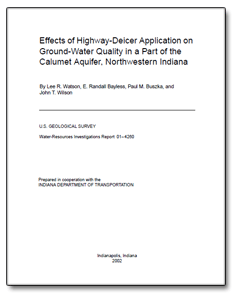Water Resources Investigations 01-4260
By Lee R. Watson, E. Randall Bayless, Paul M. Buszka, and John T. Wilson

IntroductionThe use of deicer chemicals is an important highway-safety practice used throughout Indiana and North America to keep driving surfaces free of ice and snow. The practice of applying highway-deicer chemicals has increased greatly since the 1950’s (Calabrese and Tuthil, 1978). The primary deicer chemicals used are sodium chloride, known by the mineral name halite (Gales and VanderMuelen, 1992, p. 136), and calcium chloride. Deicers typically work by dissolving in water, increasing the water’s salinity, and decreasing the freezing temperature of the water-deicer solution. The saline water and salt melt through the ice and snow on the highway and break the ice-to-road and snow-to-road bonds. As traffic breaks up the ice and snow, the resulting slurry flows, is plowed, or is splashed off the highway and onto adjacent soil. Infiltration of the saline water into soil and runoff into surface water by way of lined and unlined ditches occurs principally after thaws. If the surficial geology is permeable sand and gravel, the chemicals in highway runoff can infiltrate to the ground-water system and eventually affect nearby surface-water and ground-water quality. Chloride and sodium concentrations in drinking water are regulated by the U.S. Environmental Protection Agency (USEPA) and other agencies and organizations under a variety of standards and guidelines. The Indiana Department of Environmental Management regulates chloride concentrations in drinking water at the USEPA secondary maximum contaminant level but does not regulate sodium concentrations in water. Studies of ground-water contamination from deicer chemicals in Massachusetts and Ohio indicate needs for more data to evaluate (1) how deicing practices affect ground-water quality, (2) how to identify reliable indicators of saline water sources, and (3) how to establish baseline data to monitor deicer-affected changes in ground-water quality over time (Church, 1996; Jones and Sroka, 1997). In Indiana, data on chloride and sodium concentrations in ground water near salted highways are scarce. These data are needed particularly for parts of the State such as northwestern Indiana that receive a considerable amount of snow and frequent deicer treatments to maintain safe driving conditions. By this study, the U.S. Geological Survey (USGS), in cooperation with the Indiana Department of Transportation (INDOT), establishes baseline information about the effects of deicers at a single area of northwestern Indiana. The study area specifically was selected because available information about deicer application, hydrogeology, and climatic factors indicated a potential for measurable effects on ground-water quality. |
For additional information contact: Part or all of this report is presented in Portable Document Format (PDF); the latest version of Adobe Reader or similar software is required to view it. Download the latest version of Adobe Reader, free of charge. |
Suggested citation:
Watson, L.R., Bayless, E.R., Buszka, P.M., and Wilson, J.T., 2001, Effects of highway-deicer application on ground-water quality in a part of the calumet aquifer, Northwestern Indiana: U.S. Geological Survey Water Resources Investigations Report 01-4260.